
Big, hairy and able to run quickly, these spiders are probably responsible for more shrieks and shudders among us humans than any other types of spider in Australia. Their habit of wandering indoors only increases the chances of that. Despite some Huntsman spiders being recorded as giving a painful bite, their fearsome reputation is unnecessary.
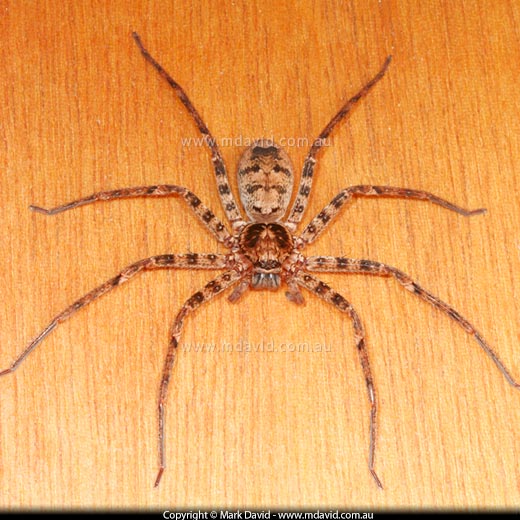
This handsome banded example of a Huntsman spider was photographed in south-east Queensland
What do they look like?
Big! Huntsmans are large spiders, growing up to 6 inches (15 cm) across if you include the legs. Many people argue that’s too many inches for any kind of spider. The biggest ones can also be very hairy and even someone comfortable with spiders can get a bit of a surprise when they encounter one. They are usually brown or grey. Some, like the one shown in the photo above, are banded.

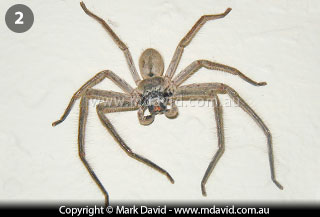
1: This big Huntsman was photographed in Buderim, in south-east Queensland. They grow them big there. This one was missing a leg but still managed to look formidable. 2: Many Huntsmans have legs which twist in a way that lets them bend forwards instead of down. This, combined with a flattened body, allows them to crawl into especially narrow crevices
Some people call them Tarantulas, but these spiders are not Tarantulas. I don’t think they’re too worried about political correctness either, so you don’t have to call them Huntspersons.
Variation
The term ‘Huntsman’ is not restricted to just a single species of spider. In fact there are more than 90 different types of Huntsman spiders in Australia.
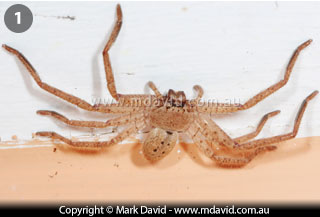
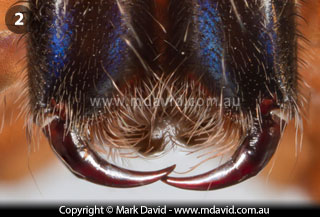
1: This one was on the ceiling. Which is another thing which many people find unsettling about these guys — the fear is that they’re going to fall onto you in the middle of the night and ruin a perfectly good sleep. I’ve never known it to happen but I guess it’s not impossible either. 2: The fangs on a Huntsman give an idea why I suggest treating even harmless spiders with caution — they’re big enough to cause a painful bite. I’ll stress again however that Huntsmans are not considered dangerous and also, they tend to run away instead of biting you.
Are they dangerous?
No. Huntsmans are not considered dangerous. In fact, most are timid creatures that go out of their way to avoid running into us. However you just have to look at the size of their fangs to realise why some of them have been known to give a painful bite. Some types of Huntsman have been known to give a bite resulting in sweating, nausea and even vomiting.
My advice is to treat any spider with caution, even Huntsmans, because even a harmless bite can be unpleasant.
The strange thing is, the way these spiders are most dangerous to people is in how we react to them. Because they have a flattened shape they can slip under the sun visor in a car — it’s probably similar for them to hiding under some bark — and then suddenly they get discovered when you flip down the visor while you’re driving. I’ve experienced that myself. People have been known to jump out of moving cars to get away from the spider in those circumstances. Now that is known to be dangerous.
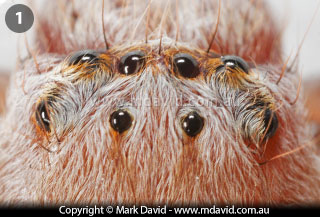
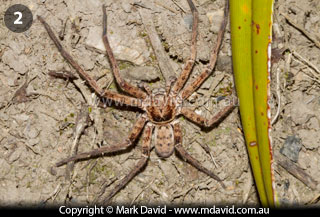
1: Despite the fact that Huntsman spiders have eight eyes, they probably have poor eyesight. 2: A beautiful large Huntsman (well, I thought it was beautiful anyway) photographed in south-east Queensland. This one had a leg span of about 12 or 13 cm (about 5 inches)
What do they eat?
Insects and other small invertebrates.
Where do you find them?
The flattened shape of Huntsmans allows them to get under sheets of loose bark and other cracks and crevices around rocks and logs. Actually, it’s better than that. They can also twist their legs around so that, instead of bending down they bend forwards. That enables them to crawl into even thinner gaps, and also gives them that distinctive legs-bending-forwards look.
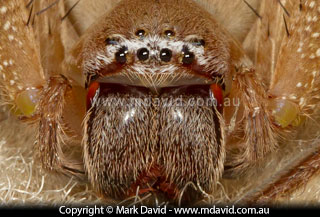
Another rather ornate variety. What’s not to like?
So if they just stayed hidden away under bark like that all the time they probably wouldn’t have such a bad reputation, but these critters get hungry and go wandering around looking for food, and that can lead to them sometimes finding themselves indoors, where they could be on the wall or ceiling or often enough, on the curtains.
If you find one in the house you don’t need to move to a new house. You can just leave it alone — they are walking insect-pest removers after all — or you can take them outside. This second suggestion is easier said than done. I’ve read that you can sweep them outside with a broom but they run really fast and I’d be nervous about hurting the spider. If I’m fast enough and the spider is slow enough, I will usually catch them in a big plastic container and take them outside. The way I do that is common enough but here’s a description of the technique.
Are they aggressive?
No. Huntsmans are not aggressive and most of the time they’ll run away when you encounter them. However some female Huntsmans might be less timid when they’re guarding their egg sack, rearing up in an aggressive fashion if get too close.
What if these spiders freak you out? What can you do about it?
I’ve always been okay with most spiders but I was developing a real fear of Huntsmans. I’d literally go into a sort of involuntary shiver just at the sight of one, and I was getting worse each time I saw one. Now I’m fine with them because I fixed my own fear of them. Here’s what I did.






